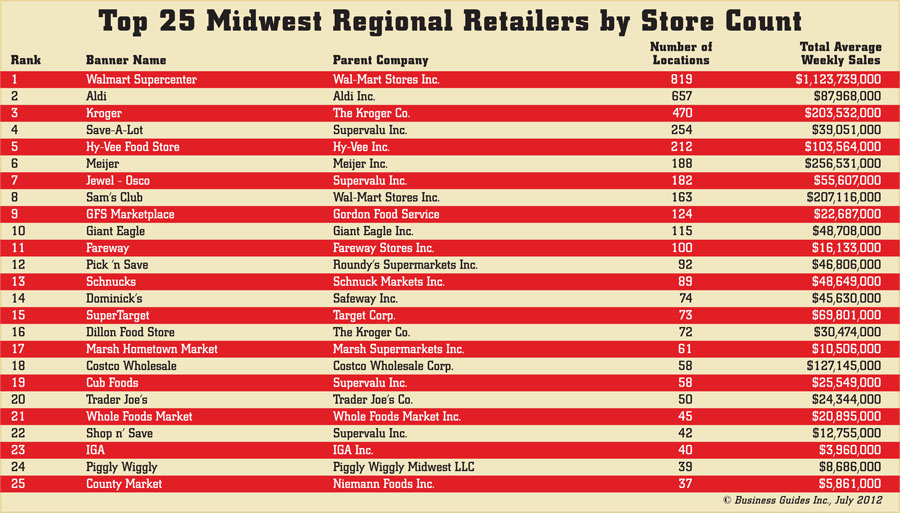Last updated on June 13th, 2024 at 12:00 pm

What makes a supermarket the best? The Shelby Report asked Brian Numainville, a principal with The Retail Feedback Group, for his thoughts.
Numainville spent more than 18 years at Nash Finch, most recently as senior director of research and public relations. In May, Numainville was named a principal at The Retail Feedback Group (www.retailfeedback.com), a firm that offers a spectrum of research, consumer insight and consulting services. Its flagship program, Constant Customer Feedback, is the first automated feedback platform specifically designed and introduced for supermarket retailers and is in use in hundreds of locations across the U.S.
Here Numainville outlines elements that make some grocery companies stand out from the rest.
1. What does a “top” supermarket operator look like, generally speaking?
I believe a top supermarket operator in today’s world is consumer centric, operationally sound, employee friendly, data focused, marketing savvy, community minded and locally driven. Whether independent operator or chain store, those retailers who embrace these principles do better serving their customers.
2. How would you describe the “new normal” as far as supermarket operations today?
The “new normal” for supermarket operations today entails many aspects that retailers should consider:
Value is the name of the game for consumers—During these challenging economic times consumers remain conservative in their spending. This means shoppers are continuing to look for discounts, living more frugally, cooking more meals at home and continuing to purchase private-label products. And many consumers, especially those who suffered financial setbacks over the last few years, indicate that they will continue these behaviors even if times improve.
Community engagement and cause marketing are important—The Cone Cause Evolution study shows that 80 percent of consumers would switch from one brand to another, if price and quality were about the same, if the other brand supported a cause. And 90 percent of consumers want companies to tell them what they are doing to support causes.
Local is big and getting bigger—The desire for taste, freshness, support of the local economy, knowing the source and reduced environmental impact is driving the local movement. Research by the Retail Feedback Group found that 83 percent of grocery shoppers expect to purchase equally, many or more locally sourced products in the next 12 months.
Health & wellness of special interest to shoppers—Consumers will spend money on health and wellness products. According to the 2012 Shopping for Health study, shoppers are looking for healthier versions of everyday foods, such as bread, pasta, rice and yogurt. And, according to the 2012 FMI Trends findings, more than 40 percent of consumers feel that health and wellness products are “worth spending a little more on” when they shop.
Social media & digital initiatives no longer optional—While social media and digital initiatives were once an option, they really are now required and expected by consumers. In addition to the majority of retailers who are using social media—Facebook in almost all cases, with half using Twitter as well—digital coupons, promotions, recipes and in-store signage are all becoming more commonplace as they are embraced by shoppers. According to FMI Trends 2012, 52 percent of consumers use technology in their grocery shopping.
[gn_box title=”Top Regional Retailers” color=”#000000″]3. What role do front line employees play in top operations? How about top executives? Do you see a widening gap between the two?
Front-line employees play a key role in top operators. The best operators have trained staff with the latitude to make sure customers are satisfied with their shopping experience. And further, top operators listen to their employees to find out what they are hearing from shoppers on the floor. Top executives also are vital to the success of top operators, especially when they are monitoring the marketplace, listening to employees and customers, and providing innovative thinking to tackle today’s challenges. The most successful organizations find ways for these groups to work together to solve consumer needs.
4. What direction do you see the supermarket industry heading in general? Do you see operators fighting only for their share and not otherwise growing or expanding? Will there be more mergers, acquisitions and closures?
The industry continues to evolve based on the changing needs of consumers and the economic conditions in the marketplace. While certainly competition is tough and many operators are fighting to simply maintain what they have today, other operators have taken advantage of the situation to acquire stores or update existing stores to better meet needs in their local markets. There will continue to be mergers and acquisitions as retailers join forces to become more efficient, expand into new geography or join forces to accomplish objectives that each could not do on their own. Other acquisitions will happen as retailers who can no longer compete falter in their markets.
5. What can independent grocers do to compete against corporate giants moving into their market? What advantages do independent grocers have?
Independents definitely can compete effectively to win on the local front. They often are an important part of the fabric of their local community. They often can be more agile compared to their larger competitors, and they have the flexibility to tailor their operation to the needs of their shoppers. I find that the successful independents often engage in several practices that help them to succeed:
- Successful independents know their market and their local competition. They stay well informed of all of the activities of the competition.
- Understanding local needs is critical…whether this is carrying locally sourced products or serving the needs of a certain population or ethnic group, successful independents know their local markets inside out.
- Community involvement is not something that successful independents take lightly. They are involved in sponsoring youth sports teams or solving pressing needs, such as hunger, in their hometowns.
- Successful independents listen…they pay attention to the wants and needs of customers and employees. They know that listening will provide fresh insight into what they need to do to succeed.
- Innovation is a hallmark of successful independents…whether it is engaging in conversation with consumers through social media or mobile marketing, these retailers embrace change and find new ways to serve their customers.
6. How and why do the big players stay so big?
The big players in today’s world have many economies of scale that allow them to operate efficiently and take advantage of their size in procurement, operational efficiencies and marketing, to name just a few advantages. At the same time, many of the larger chains have been struggling for various reasons, despite their size. Smaller players, like independents, have other advantages, like those outlined above, which allow them to compete effectively with the larger chains.
7. Do you believe we will continue to see the introduction of new formats? What is next?
According to FMI research, conventional supermarkets are the primary choice of only 64 percent of shoppers. One size no longer fits all shoppers.
FMI Research/Nielsen US Retail Trends (March 2, 2012) indicates that since 2005, the number of dollar stores and hard discount stores grew by 23 percent and supercenters by 48 percent while supermarket numbers only grew by 4 percent.
Much of the buzz has been around small store growth. While FMI research indicates that 25 percent of shoppers shop at small format stores, very few consider it as their primary store (2 percent). And 75 percent of consumers never shop at small format stores.
I believe we will continue to see the growth of a variety of formats AND of formats carrying food. Whether dollar stores, or even hardware stores like Menards, many different types of retailers now have a large section of food items, and this will continue as retailers try to drive additional traffic through their stores.
The next wave of format change is likely to be focused on the increased integration and utilization of technology in the store regardless of the store size. Secondly, we may see an increase in initiatives featuring “window shopping” by allowing customers to scan QR codes and place an order for either pickup or delivery. Finally, I think we will see renewed attempts by traditional operators at trying online ordering with either pick up or delivery.
8. How important is new technology, particularly social media, in the success or failure of a supermarket operation?
Social media provides a tremendous opportunity for retailers to shift what used to be a one-way communication channel into a two-way means of conversing with their customers and creating personalized connections as well as delivering value. But it is important to think of tools like Facebook as vehicles to engage in a relationship with customers as opposed to just another way to deliver ads or sale items.
Of course, social media tools also can be used effectively for promotions and marketing. For instance, consider new apps that allow for “on the spot” promotions based on “checking-in” at a store or other location. But again, it is always important to keep in mind that building a relationship is paramount even when utilizing social media for promotions.
Retailers need to be prepared, as they may not like everything they hear through social media. I have actually heard some retailers question why they can’t simply “delete” the negative comments and, of course, this is not possible with social media. Social media is a public forum where lack of responsiveness and transparency can have very negative impacts on a store or brand. Instead, retailers need to find ways to respond to customer concerns, as well as praises, in this new space in “real time.”
Further, a threat to retailers that social media introduces is the ability for brands to directly connect with consumers, effectively bypassing the retailer. This may continue to grow as more brands utilize social media for promotions and communication with consumers.
The bottom line is that over time, consumers will begin to cut off retailers who do not engage with them where they are in a transparent and meaningful way through tools like social media and other technology.












we are looking for supermarket consulting in the area of Sacramento California and we pay for services rendered plus honor you with tassel participation long term